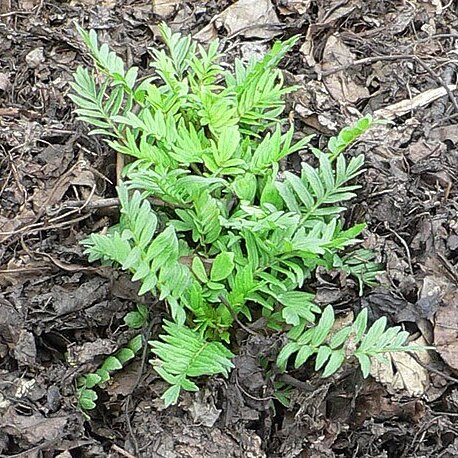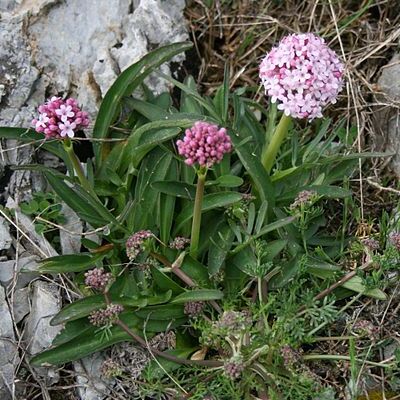Perennial herbs, with a short, often strong-smelling rootstock. Lowest leaves in a basal rosette, higher ones decussate, simple, odd-pinnate or deeply pinnatifid, exstipulate but those of one pair often connected by a raised line, radical ones often long-petioled. Flowers small, ☿or unisexual, bracteate, sessile, cymose; cymes united into an often large, ter-minal panicle or corymb. Bracts small, opposite, persistent, oblong or linear, on the ultimate branchlets of the inflores-cence only one bract of each pair flower-bearing. Calyx small, persistent; limb during anthesis short, inrolled, deeply divided into 10 or more segments, these in fruit unrolling, much accrescent, finally widely patent, plumose, pappus-like. Corolla gamopetalous, caducous after anthesis, small; tube funnel-shaped, much widened above the very short, narrow basal part, unequalsided; lobes 5, patent, oblong, imbricate in bud. Stamens 3, inserted about halfway down on the corolla-tube, alternating with the lobes, exserted or not; filaments thin; anthers small, versatile, 2-celled, oval-suborbicular, or sub-biglobose, cells opening lengthwise. Ovary inferior, 3-celled, only one cell perfect, 1-ovuled, the two others barren or imperfect; ovule pendulous. Style thin, filiform, shortly 3-lobed or subentire, glabrous, exserted or not. Fruit small, dry, indehiscent, 1-seeded, ovate-oblong, much compres-sed, with 3 dorsal, 1 ventral, and 2 mar-ginal ribs, 1-celled, the two barren or imperfect cells either enlarged or redu-ced to narrow ridges. Seed pendulous; albumen absent or scanty.
Perennial herbs, vines or subshrubs, usually glabrous or sparsely hairy with short simple hairs, with a bitter taste and peculiar smell especially when dry, fleshy (woody or tuberous) roots, sometimes stoloniferous, occasionally gynodioecious or polygamodioecious. Leaves petiolate to nearly sessile, exstipulate; radical leaves entire or toothed, in basal rosette, often long-petioled; cauline leaves pinnatifid, or once–twice-pinnatisect. Inflorescence usually a dichasial cyme or thyrse, sometimes lax or subcapitate; bracts free, opposite, persistent, on the ultimate branchlets only 1 bract of each pair is flower-bearing; bracteoles present. Flowers hermaphrodite or unisexual, small, irregular. Calyx small, persistent; limb short during anthesis, inrolled, deeply divided into 10 or more segments, these unrolling in fruit and (in most species) developing into 5–15 plumose awns. Corolla funnel-shaped or campanulate, caducous after anthesis, small, gibbous, sometimes ± hairy in the throat; lobes (3, 4)5, oblong, patent, imbricate in bud. Stamens 3 (rarely 4, and occasionally 1–2 by abortion), inserted toward the top of the corolla-tube, usually exserted, alternating with the corolla-lobes; filaments thin; anthers small, 2-thecous. Style filiform, shortly 3-lobed or subentire, glabrous; stigma simple or 3-lobed. Fruit small, indehiscent, much compressed, with 3 dorsal, 1 ventral, and 2 marginal ribs.
Herbs, perennial. Plants hermaphroditic, gynodioecious, polygamo-dioecious, or dioecious, glabrous or variously pubescent, villous or hirsute, hairs 1-to several celled, white or translucent. Rhizomes elongate, with fibrous roots, or rhizomes reduced, with fascicled, often clavate, roots. Taproots absent (Chinese spp.). Stolons present or absent. Basal leaves rosulate, petiolate or spatulate, undivided, pinnate or pinnatifid, persistent or caducous. Cauline leaves opposite, petiolate to sessile; petiole length typically diminishing upward along stem; blade pinnate, pinnatifid, pinnatisect, or undivided. Inflorescence paniculiform or corymbiform, at anthesis: flowers in remote terminal clusters or in a densely capitate head, branches elongating in fruit; lowermost bracts often lobed, bracts otherwise simple and entire; bracteoles simple, similar to bracts; flowers bisexual, male (not in China?) or female. Calyx a ring at anthesis, unfurling into 5-15 white, plumose segments, 4-8 mm, in mature fruit. Corolla funnelform, rotate or salverform; tube usually gibbous near base; limb 5-lobed. Stamens 3 (4 in Valeriana kawakamii), inserted on corolla tube. Achene compressed dorsally, 3-veined on abaxial side, 1-veined on adaxial side, sterile locules reduced; crowned by persistent, plumose calyx, segments 2-7 mm.
Fls perfect or unisexual; cal initially involute and inconspicuous, later enlarged and spreading, usually with several or many long, setaceous, plumose, pappus-like segments; cor-tube sometimes gibbous at base, the 5 lobes equal or subequal; stamens 3; ovary basically tricarpellate, but 2 of the carpels vestigial; stigma 3-lobed; fr a nerved achene; annual or (ours) perennial herbs with entire to bipinnatifid lvs, the fls in corymbiform to paniculiform or thyrsoid infls of basically determinate nature. 200, nearly cosmop.
Perennial herbs, rarely climbers, occasionally subshrubs which are somewhat woody at the base; glabrous or sometimes sparsely pubescent with simple hairs; often with a characteristic pungent smell of “valerian” from the rizomes, especially when dry.
Corolla imbricate, funneliform or campanulate, slightly saccate at the base, with (3–4) 5 lobes.
Stamens usually 3, epipetalous, alternating with the corolla lobes, frequently exserted.
Calyx small and inrolled but usually developing in fruit into 5–15 plumose awns.
Inflorescence a dichasial cyme or thyrse, rarely subcapitate.
Some species gynodioecious or polygamodioecious at anthesis.
Fruit an achene, compressed, with 6 filiform ribs.
Style with 3 short lobes or slightly emarginate.
Flowers hermaphrodite or unisexual.


